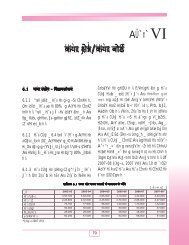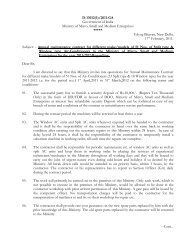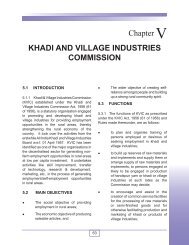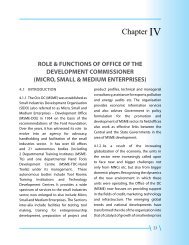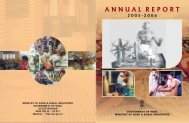Evaluation Study MSE Cluster Development - Ministry of Micro ...
Evaluation Study MSE Cluster Development - Ministry of Micro ...
Evaluation Study MSE Cluster Development - Ministry of Micro ...
You also want an ePaper? Increase the reach of your titles
YUMPU automatically turns print PDFs into web optimized ePapers that Google loves.
Chapter No:2 – The General Pr<strong>of</strong>ile <strong>of</strong> Sampled <strong>Cluster</strong>sEach <strong>of</strong> these three clusters have reported specific reasons for the present andanticipated shortages in the required inputs, and even anticipate that these seriousconstraints are likely to increase in the future and if the issue is not addressedappropriately and in time it is bound to affect the very survival <strong>of</strong> these clusters. In thecase <strong>of</strong> the Ball Bearing <strong>Cluster</strong> in Jaipur the units have been facing a severe shortage <strong>of</strong>steel as well as a steep rise in prices. In the case <strong>of</strong> the Plastic <strong>Cluster</strong> in Aluva, Keralawhere plastic granules are produced from plastic waste there has been a fall in thesupply <strong>of</strong> waste as the garbage containing waste plastic is not being properly segregatedand is increasingly being used for land filling.In case <strong>of</strong> the Rice Milling <strong>Cluster</strong> in Kallady the input constraints have taken a veryserious turn. This is because local paddy production and procurement in Kerala has beensteadily declining as farmers turn to cultivating more lucrative commercial crops or toeven stop cultivation altogether, diverting land to alternate uses. What has madematters worse is that the adjacent states like Karnataka and Tamil Nadu have nowrestricted or even banned the export <strong>of</strong> paddy to other states and Kerala’s large cerealrequirement is provided in terms <strong>of</strong> Rice rather than paddy.It is also observed in Table 2.7 that while 7 <strong>of</strong> the 9 sampled clusters procure inputsfrom local sources in close proximity <strong>of</strong> the cluster, there are two specific clusters whichprocure their inputs from sources in a larger region.Table No. - 2.7: LOCATION OF INPUT SOURCES FOR SAMPLED CLUSTERSPrimary Goods Based <strong>Cluster</strong>sInputs are available inSl <strong>Cluster</strong> CloseProximityRegionalProximity1. Bamboo <strong>Cluster</strong> Dimapur √2. Food Processing <strong>Cluster</strong> Muzaffarpur √3. Leather Goods <strong>Cluster</strong> Agra √4. Leather Goods <strong>Cluster</strong> Shantiniketan √5. Plywood <strong>Cluster</strong> Perambavoor √6. Rice Milling <strong>Cluster</strong> Karnal √7. Rice Flakes <strong>Cluster</strong> Ahmedabad √8. Rice Milling <strong>Cluster</strong> Kalady √9. Rubber <strong>Cluster</strong> Chenganacherry √Secondary Goods Based <strong>Cluster</strong>sNationalProximityInputs are available inSl <strong>Cluster</strong> CloseProximityRegionalProximityNationalProximity10. Ball bearing <strong>Cluster</strong> Jaipur √11. Bell metal <strong>Cluster</strong> Khurda √12. Bell metal <strong>Cluster</strong> Hazo √13. Brass Utensil <strong>Cluster</strong> Pareo √39





